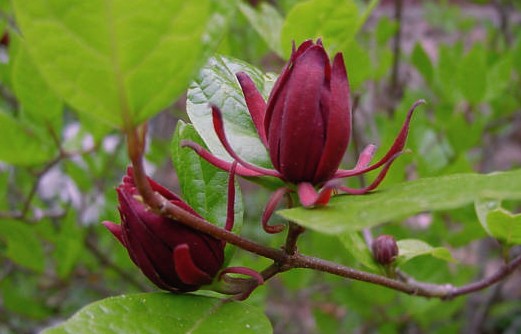Leaf_sweetshrub
(Calycanthus floridus glaucus)

Description
Calycanthus, called sweetshrub, is a genus of flowering plants in the family Calycanthaceae. The genus includes two to four species depending on taxonomic interpretation; three are accepted by most 21st century sources. Calycanthus plants are deciduous shrubs, growing to 4 m (13 ft) tall. The leaves are opposite and undivided. The plants are aromatic. The flowers are typical of the family Calycanthaceae in lacking distinct sepals and petals, but instead having spirals of tepals. Flowers are produced from spring onwards, until October in the case of C. occidentalis. The flowers of the two North American species are scented, 4–7 cm (1.6–2.8 in) across, with numerous dark red to burgundy to purplish brown tepals. C. chinensis has broader tepals, the outer ones white flushed with pink, the inner ones mostly yellow with purple marks at the base. The fruit is an elliptical dry capsule, containing numerous seeds. C. floridus and C. occidentalis are pollinated by beetles. Their flowers produce small protein-rich growths that feed beetle pollinators. C. occidentalis has been shown to produce chemicals that mimic fermenting fruits that attract beetles in the families Nitidulidae and Staphylinidae. The genus Calycanthus was created by Carl Linnaeus in 1759, with the sole species Calycanthus floridus. In 1762, he added Calycanthus praecox, now treated as Chimonanthus praecox. Calycanthus species are cultivated as ornamental plants by plant nurseries, including in the United States and England. Calycanthus floridus is planted in gardens, as a specimen shrub, or for hedges. The English naturalist Mark Catesby drew it as the support for the bird he called "Garrulus Carolinensis The Chatterer" (now Bombycilla cedrorum) in a work published from 1731 onwards. He described the shrub as growing in "remote and hilly parts" and having bark "as odoriferous as cinnamon". The colonial planters of the Carolinas transplanted it into their gardens, and the botanist Peter Collinson described it to Linnaeus and imported it into England from Charleston in the Province of South Carolina around 1756. Calycanthus occidentalis is planted in traditional, native plant, and wildlife gardens, and for natural landscaping and habitat restoration projects, primarily in California and the Western United States. It was introduced into cultivation in 1831.
Taxonomic tree:







